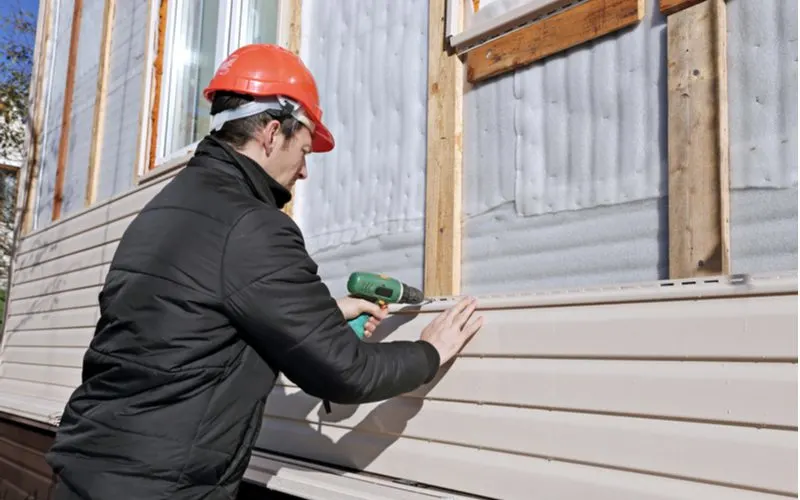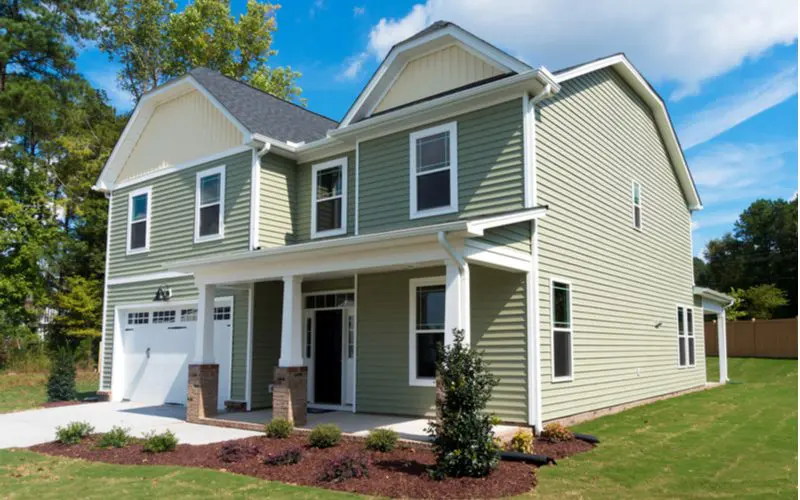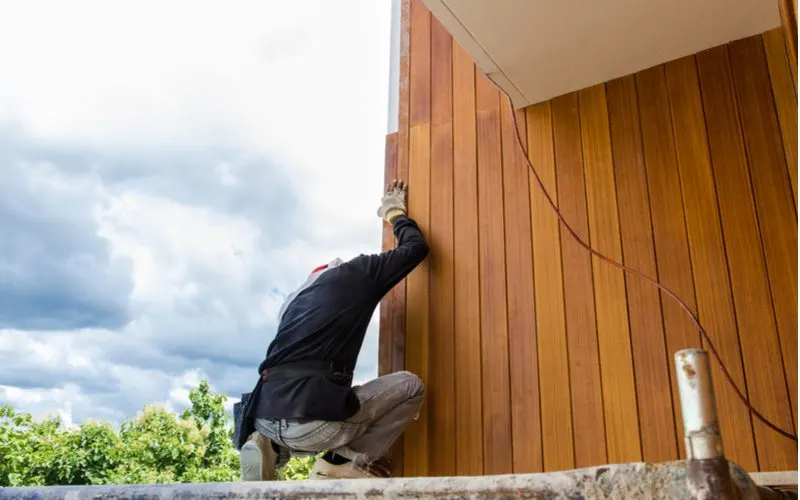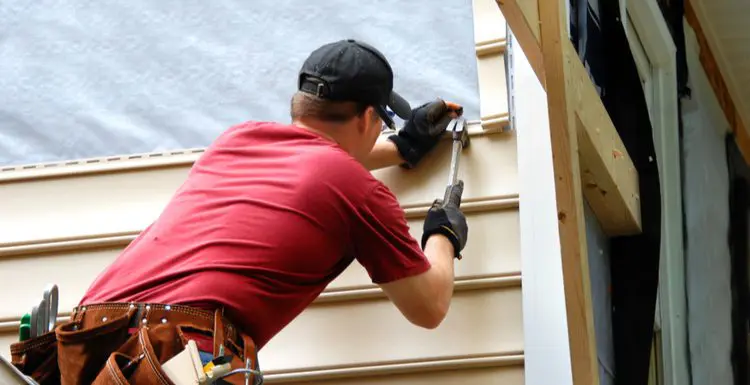Whether you’re building a home or doing a small renovation project, the outward appearance of your home can significantly add to its value.
When it comes to figuring out the cost of a house, it’s crucial to know how much you can expect to pay based on the details you want on your house. And spoiler alert: siding isn’t cheap.
Average Cost to Side a House

Kingarion/Shutterstock
If you’re researching the cost of siding a home, your siding is likely in rough shape. Bummer.
But don’t worry—it’s not quite as expensive as you think. And once you’re done, you’ll be covered for at least a decade. Be sure to read this guide to the end to learn how to maximize your investment.
The Quick Answer
Nationally, the average cost to build a house is around $12 per square foot. Expect to pay between $5 and $20 per square foot. Several important factors will determine your final costs:
- Square footage
- Material Used
- Labor costs
- Supply and Demand
Each of these components will affect the bottom line of your budget. Below, we’ll show you how these factors impact costs and what you can do to reduce them.
Factors Affecting Home Siding Costs

Konstantin L/Shutterstock
Home improvement projects are all the rage this year, and there’s been no better time to get to some of the projects you’ve been meaning to for years.
Siding is one project that doesn’t have to take much time or effort, but it can transform the exterior of your house and add lots of value and curb appeal.
1. Square Footage
The first thing you have to consider when planning how much it will cost to build a house is the house’s square footage. The larger your home, the higher the cost will be. Additionally, a few other contributing factors will impact your total bill.
For instance, the shape of your house can play a big role in your final costs. For most homes, materials come in pre-cut shapes, especially vinyl, but homes with irregular shapes cost more.
Builders will have to make extra cuts to fit the edges of the siding material together like a jigsaw puzzle.
Another aspect that’s often overlooked is the removal of the old siding. This is something you want to hire experts to do because of the possibility of damage to the material underneath.
Again, the larger your home, the more it will cost to remove the old siding and start fresh. To cut costs, determine beforehand if your siding simply needs a good pressure wash to look as good as new.
If the siding does need to be replaced, consider whether it only needs to be replaced in certain areas. If all of your siding truly needs to be replaced, calculate the total square footage of your home. You can measure yourself or find the number on your county assessor’s website.
2. Material Used
Besides square footage, this is the factor with the biggest impact on your cost when it comes to replacing your house’s siding. There are a plethora of companies and materials to choose from, all of which range in price.
| Material | Average Price |
|---|---|
| Wood Siding | $2-$6 |
| Vinyl Siding | $5 |
| Metal Siding | $3-$11 |
| Fiber Cement Siding | $6 |
| Brick Siding | $9 |
| Stone Siding | $20 |
The type of material you choose hinges on the material’s durability, upkeep, and installation costs. Vinyl is the easiest siding material to install and is less expensive in terms of installation costs.
However, materials like brick, stone, or fiber cement are the most durable and require less upkeep. The cost of your materials makes up the bulk of the cost of building a house.
If you plan on being in the home for a long time, we recommend choosing a type of siding that’ll last for decades. If not, choose vinyl or wood. Also, consider which material best complements the look of your home best.
If you don’t want to go with the same material that was originally used for siding your home, consider what new materials complement the design elements that already exist. Think of the overall, finished picture instead of just a piece of the puzzle.
3. Labor Costs
Labor costs will fluctuate slightly based on the material you choose, the size and shape of your house, and the number of man-hours necessary to complete the job.
This expense is likely to make a smaller dent in your budget than material costs.
Home Shape
If you have a standard-shaped house without many dips, curves, turrets, or eaves, then your installation costs will likely be less.
For a typical 2,000-square-foot, rectangular-shaped house, the national average installation cost is around $10,000.
For homes that have unique architectural details, budget an extra $500–$2,500. For more exact cost estimations, get a quote from a siding contractor. We always recommend getting at least three quotes.
Hourly or By-Project Rates
Experienced contractors will either charge by the hour or by the project. If you choose a material that’s a little more difficult to install, such as stone, then a per-project charge will save you money in the long run.
On the other hand, if you choose a less expensive material, like vinyl, then an hourly rate will be the best deal. Keep in mind that, when charging by the hour, contractors are likely to overestimate the amount of time it will take.
Still, make sure your budget has some cushion room in it for unexpected issues that may arise. The same goes for the project time or the amount of material needed to complete the job.
Timing of the Project
Believe it or not, the time of year you decide to complete your siding project may affect the cost of labor. Spring and summer may seem like the most optimal times to replace the siding on your home. However, due to rising demand, this is actually the most expensive time of year to complete such a project.
If you wait until the winter or the fall, contractors’ estimates are likely to decrease because of the lack of demand for this sort of job.
Keep in mind, though, that installing some materials in colder weather can prove to be more challenging, as materials such as vinyl contract in cold weather and expand in warmer weather.
Some materials can even crack and be damaged during cold-weather installations, so it’s important to make sure your contractor is experienced with installing your chosen material in low temperatures if you make that choice.
Typically, the mild fall seasons are best to side a house, price-wise and material-wise.
4. Supply and Demand
Another thing to keep in mind when budgeting is supply, demand, and availability. During the last few years, the availability of construction and production workers has decreased despite increasing demands for labor and materials.
Depending on the area you live in, this decrease in the availability of labor and materials can lead to increased pricing estimates by contractors. That’s why it’s important to research your specific area and leave room in your budget for this sort of demand.
It is also likely that your first-choice material may not be available right away, and you can be wait-listed. If you’re not particular about one material, it’s better to select several other materials as a backup.
Otherwise, you will be at the mercy of fluctuating supply and demand. One of my friends recently got a quote to re-side the front of his house with traditional wood siding.
However, lumber prices were still at record highs, so he went with cement board instead. Traditionally, this would have been about three times the cost. But because wood was so expensive, he was able to upgrade for the same price.
Frequently Asked Questions

P.Kasipat/Shutterstock
Have more questions about siding your home? Let’s cover some more common issues we’re asked about by our readers.
How do I know when it’s time to replace my siding instead of simply cleaning it?
Damage to your siding is a good indicator that it’s time to replace it, along with some of these tell-tale signs:
- Siding is cracked or rotting
- Your siding has blisters or bubbles
- Your siding is growing fungus, mold, or mildew
- It’s severely fading
- You need to paint it regularly
Can I install my new siding myself?
It’s important to hire a pro to remove old siding and install new siding. The corners have to be expertly cut and joined together around the edges of the house and windows, as well as any other architectural elements of the home.
Professionals know how to do their best to prolong the life of your material and do a structurally sound, good-looking job.
While you can do it yourself, the job will likely take much longer than you think, leaving the home exposed to the elements in the meantime.
Do I have to use a moisture barrier along with my siding?
If you live in a wet or humid area, it’s a good idea to use a moisture barrier to prevent damage. If you use a material that easily absorbs water, like wood or stone, it’s a good idea to use it to increase the life of the material and prevent rotting or warping. When in doubt, always use one.
So, What’s the Cost to Side a House?
Replacing siding for your house can be a pricey project, especially after considering the square footage, material costs, and labor and demand costs.
However, it contributes significantly to the exterior aesthetic and upkeep of your home. When making your final decisions, consider what you’ll most enjoy for years to come.
You can save money by cutting corners in the short run, but investing in the best materials and labor ensures your happiness in the long run.

